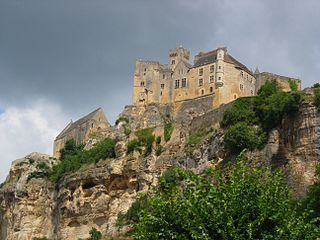- Château de Beynac
-
The Château de Beynac is a castle situated in the commune of Beynac-et-Cazenac, in the Dordogne département of France. The castle is one of the best-preserved and best-known in the region.
This Middle Ages construction, with its austere appearance, is perched on top of a limestone cliff, dominating the town and the north bank of the Dordogne River.
Contents
History
The castle was built from the 12th century by the barons of Beynac (one of the four baronies of Périgord) to close the valley. The sheer cliff face being sufficient to discourage any assault from that side, the defences were built up on the plateau: double crenellated walls, double moats, one of which was a deepened natural ravine, double barbican.
The oldest part of the castle is a large, square-shaped, Romanesque keep with vertical sides and few openings, held together with attached watch towers and equipped with a narrow spiral staircase terminating on a crenellated terrace. To one side, a residence of the same period is attached; it was remodelled and enlarged in the 16th and 17th centuries. On the other side is a partly 14th century residence side-by-side with a courtyard and a square plan staircase serving the 17th century apartments. The apartments have kept their woodwork and a painted ceiling from the 17th century. The Salle des États (States' Hall) has a Renaissance sculptured fireplace and leads into a small oratory entirely covered with 15th century frescoes, included a Pietà, a Saint Christopher, and a Last Supper in which Saint Martial (first bishop of Limoges) is the maître d'hôtel.
At the time of the Hundred Years' War, the fortress at Beynac was in French hands. The Dordogne was the border between France and England. Not far away, on the opposite bank of the river, the Château de Castelnaud was held by the English. The Dordogne region was the theatre of numerous struggles for influence, rivalries and occasionally battles between the English and French supporters. However, the castles fell more often through ruse and intrigue rather than by direct assault, because the armies needed to take these castles were extremely costly: only the richest nobles and kings could procure them.
The castle was bought in 1962 by Lucien Grosso who has restored it.
Visitors to the castle can see sumptuous tapestries showing hunting and other scenes from the lives of the lords of the period. The Château de Beynac has been listed as a monument historique by the French Ministry of Culture since 1944.
Beynac castle has served as a location for several films, including Les Visiteurs by Jean-Marie Poiré, in 1993, La Fille de d'Artagnan by Bertrand Tavernier, in 1994, Ever After by Andy Tennant, in 1998, and Jeanne d'Arc by Luc Besson, in 1999. The village of Beynac below the chateau, also served as a location for the film Chocolat by Lasse Hallström, in 2000.
Barons de Beynac
- Maynard (1115-1124)
- Adhémar (1147-1189)
- Richard Cœur de Lion, king of England (1189-1199)
- Pons I (1200-1209)
- Gaillard (1238-1272)
- Pons II (1251-1300)
- Adhémar II (1269-1348)
- Pons III (-1346)
- Boson, known as Pons (1341-1348)
- Pons IV (1362-1366)
- Philippe (-1403)
- Pons V (1461-1463)
- Jean-Bertrand (-1485)
- Geoffroy I (-1530)
- François (-1537)
- Geoffroy II (-1546)
- Geoffroy III
- Guy I (1643-)
- Isaac
- Guy II
- Pierre
- Marie-Claude (1732-18??)
- Christophe-Marie (1764-18??)
- Louis, dit Ludovic (1784-18??)
- Christophe-Amable-Victoire (1831-18??)
- Soffrey-Paul-Louis-Armand (1857-19??)
- Amable-Avit-Christophe (1895-)
- Pierre-Aimé-Soffrey-Armand (1929-)
Photos
See also
External links
- This article incorporates information from this version of the equivalent article on the French Wikipedia.
Categories:- Châteaux in Dordogne
- Official historical monuments of France
Wikimedia Foundation. 2010.














